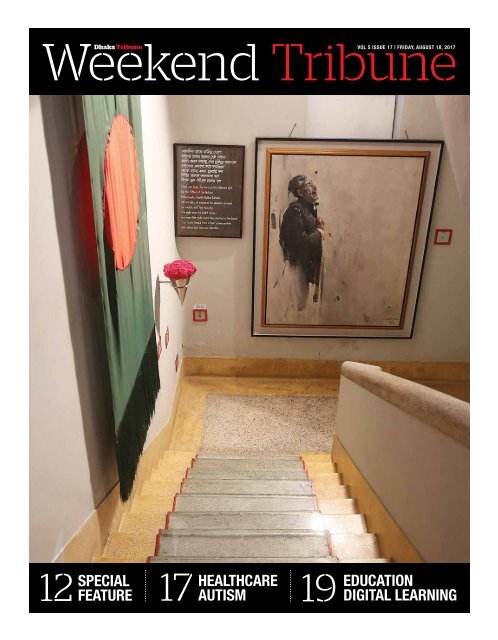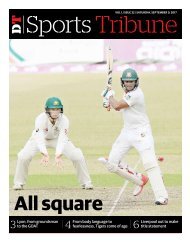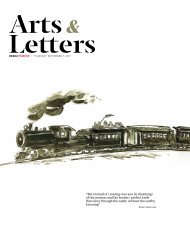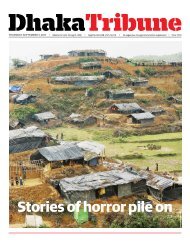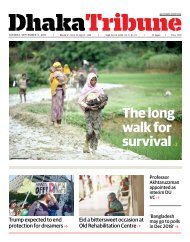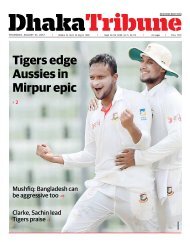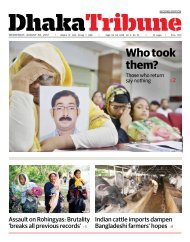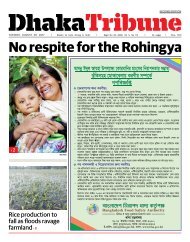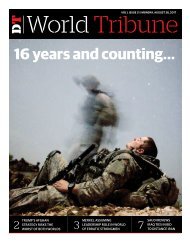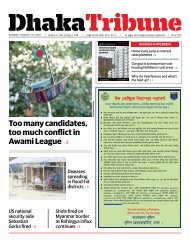Weekend-5-16
You also want an ePaper? Increase the reach of your titles
YUMPU automatically turns print PDFs into web optimized ePapers that Google loves.
Dhaka Tribune<br />
vol 5 Issue 17 | friDAY, august 18, 2017<br />
12 Special<br />
feature<br />
17 Healthcare<br />
Autism<br />
19 Education<br />
Digital learning
CONTENTS<br />
Volume 5 | Issue 17 | August 18, 2017<br />
Editor<br />
Zafar Sobhan<br />
Features Editor<br />
Sabrina Fatma Ahmad<br />
Magazine Editor<br />
Farina Noireet<br />
Deputy Magazine Editors<br />
Khan N Moushumi<br />
Shuprova Tasneem<br />
<strong>Weekend</strong> Tribune Team<br />
Saudia Afrin<br />
Mahmood Hossain<br />
Moumita Ahmed<br />
Tasfia Huda<br />
Baizid Haque Joarder<br />
Saqib Sarker<br />
Mahmood Sadi<br />
Sabiha Akond Rupa<br />
Contributors<br />
Minaal Choudhury<br />
Mahmud Rahman<br />
Noshin Tasnuba<br />
Cartoons<br />
Syed Rashad Imam Tanmoy<br />
Priyo<br />
Graphics<br />
Md Mahbub Alam<br />
Alamgir Hossain<br />
Shahadat Hossain<br />
Colour Specialist<br />
Shekhar Mondal<br />
Advertisement<br />
Shahin Ahsan<br />
Production<br />
Masum Billah<br />
Circulation<br />
Masud Kabir Pavel<br />
Website<br />
dhakatribune.com/weekend<br />
facebook.com/<strong>Weekend</strong>Trib<br />
Email your letters to:<br />
weekend@dhakatribune.com<br />
Editor’s note<br />
Dear Readers,<br />
As we approach mid August, we find<br />
there is little in way of respite from the<br />
heat, rain or traffic that pretty much<br />
sums up life in Dhaka at the moment.<br />
But as we delve beyond the external<br />
hazards of everyday life, and think of<br />
this month in retrospect, we realise<br />
that August, like that of March and<br />
December, occupies a significant place<br />
in our hearts.<br />
In light of August 15, National<br />
Mourning Day, and in remembrance<br />
of the Father of the Nation, our photo<br />
story this week features images from<br />
the Bangabandhu Memorial Museum –<br />
a glimpse into the simple life of a great<br />
News<br />
2 News<br />
3 Meanwhile<br />
Features<br />
4 Tailored | Men’s fashion<br />
5 Trending | Women’s fashion<br />
6 Recipes | Desserts<br />
8 Cafe society | Atmosphere matters<br />
9 GFC meals | Review<br />
10 Photo Story | Remembrance<br />
12 Special feature | Commentary<br />
15 Tech<br />
<strong>16</strong> Healthcare | Solutions<br />
17 Healthcare | Autism<br />
18 Environment | Conserving water<br />
19 Education | Digital learning<br />
Regulars<br />
20 Stay in<br />
man.<br />
This August 14 was also the 70th<br />
anniversary of Partition, and we have a<br />
special feature which talks about how<br />
after all these years, we are far from<br />
breaking out of the shackles of our<br />
historical legacies.<br />
Finally, we end with a couple of<br />
articles on healthcare – one on the issue<br />
of doctors’ appointments and access<br />
to proper medical counselling, and the<br />
other on a recently held workshop on<br />
autism.<br />
Wishing our readers a pleasant<br />
weekend.<br />
Farina Noireet<br />
On the cover<br />
The Staircase at<br />
Bangabandhu Memorial<br />
Museum<br />
Photo: Syed Zakir Hossain<br />
WEEKEND TRIBUNE | FRIDAY, AUGUST 18, 2017<br />
1
News | world at a glance This week<br />
Obama’s Charlottesville<br />
tweet is now the most-liked<br />
tweet ever<br />
The tweet Obama wrote in<br />
response to Saturday’s white<br />
nationalist rally in Charlottesville,<br />
Virignia, became the most-liked<br />
tweet ever, as of 10:07 pm on<br />
Tuesday, according to Twitter,<br />
with 2.8 million likes.<br />
“No one is born hating<br />
another person because of<br />
the color of his skin or his<br />
background or his religion...,”<br />
the former president tweeted<br />
Saturday, along with a 2011<br />
photo of himself greeting a<br />
group of children through a<br />
window taken by former White<br />
House photographer Pete Souza at a daycare<br />
facility next to his daughter Sasha’s school in<br />
Bethesda, Maryland.<br />
Obama’s tweet is also the fifth most<br />
retweeted tweet ever. His tweet was retweeted<br />
1.2 million times as of late Tuesday night.<br />
Photo: Pete Souza<br />
Nigeria suicide bombers kill<br />
28, wound 82<br />
Three women suicide bombers blew<br />
themselves up at the entrance to a camp for<br />
displaced people in northeast Nigeria on last<br />
Tuesday, killing 28 people and wounding 82.<br />
The attack -- the latest in a string of<br />
assaults in the troubled region -- took<br />
place in the town of Mandarari, 25 km<br />
from Maiduguri, the capital of Borno<br />
state, said Baba Kura, a member of a<br />
vigilante force set up to fight jihadists.<br />
Ibrahim Liman, the head of a local<br />
anti-jihadist militia force, confirmed<br />
the details of the attack, and said that<br />
more than 80 injured had been taken to<br />
Maiduguri hospital.<br />
A source at the hospital said a “huge<br />
number” of patients had arrived.<br />
Photo: AFP<br />
Local<br />
Gunfire,<br />
explosions<br />
rock<br />
Panthapath<br />
hotel<br />
A 21 year old militant has died, possibly<br />
due to his own explosive devices,<br />
after a standoff with law enforcement<br />
agencies on Tuesday morning.<br />
Police, including the Counter<br />
Terrorism and Transnational Crime<br />
(CTTC) unit, Detective Branch and<br />
regular members in riot gear, along<br />
with Rapid Action Battalion and fire<br />
service, sealed off the area to deal with<br />
the terrorist threat, which was speedily<br />
taken care off in a few hours. The raid<br />
was titled “Operation August Bite”.<br />
The deceased has been identified<br />
as Saiful Islam, a 21-year-old from<br />
Dumuria in Khulna. He was a student<br />
at BL College in Khulna and had been<br />
planning an attack on Dhanmondi<br />
Road 32 at the Bangabandhu Memorial<br />
Museum on Tuesday.<br />
According to IGP Shahidul Hoque,<br />
“Saiful was a member of Chhatra Shibir<br />
before joining New JMB.”•<br />
News: Mahmud Hossain Opu<br />
India opens first Partition museum<br />
A new museum on the Partition of the Indian<br />
subcontinent opens this week, as the two<br />
South Asian giants mark seven decades as<br />
independent nations.<br />
The museum, housed in the red-brick Town<br />
Hall building in the north Indian border city<br />
of Amritsar, include photographs, newspaper<br />
clippings and donated personal items meant<br />
to tell the story of how the region’s struggle for<br />
freedom from colonial rule turned into one of<br />
its most violent episodes, as communal clashes<br />
left hundreds of thousands of Hindus, Muslims<br />
and Sikhs dead and another 15 million displaced<br />
from their ancestral homes. Screens show video<br />
interviews with the now-elderly survivors.<br />
The last of the museum’s 14 galleries is<br />
called the Gallery of Hope, where visitors are<br />
invited to scribble messages of love and peace<br />
on leaf-shaped papers before hanging them on<br />
a barbed-wire tree. The idea is to have visitors<br />
participate in the “greening” of the tree and to<br />
think of peace and reconciliation between the<br />
torn nations.<br />
Photo: AP<br />
2<br />
WEEKEND TRIBUNE | FRIDAY, AUGUST 18, 2017
. . . Meanwhile<br />
Photo<br />
of<br />
the week<br />
Say what<br />
76-year-old hunk wins<br />
Brazilian beauty pageant<br />
A 76-year-old former construction worker in<br />
Brazil now has a new title to go by besides<br />
grandpa – he is Sao Paulo’s handsomest<br />
elderly man.<br />
A potter at his workshop in Munshiganj.<br />
Photo: Mehedi Hasan<br />
Jose dos Santos Neves<br />
beat out 24 other hunks<br />
to win the coveted title in<br />
Sao Paulo’s Handsomest<br />
Elderly Man 2017, a pageant<br />
for senior citizens held on<br />
Thursday.<br />
Naturally, he was proud.<br />
“Participating and winning<br />
this little trophy means a lot<br />
to me mainly because when<br />
you’re as old as I am, it’s an<br />
achievement,” he said.<br />
The pageant is held by<br />
the Sao Paulo state health<br />
department to promote selfesteem<br />
among older people.<br />
Santos competed against<br />
other men between ages 62<br />
and 96.<br />
He hopes his win inspires other older men<br />
to make the most of life.•<br />
News and photo: Huffungton Post<br />
Aries (Mar21-Apr19): As the week begins,<br />
you may feel it necessary to manipulate<br />
a situation to get your desired outcome.<br />
It might be better to state your intentions<br />
openly, as this can help to get things<br />
moving in the right direction.<br />
Taurus (Apr20-May20): It’s all happening<br />
on the home front this week, with potent<br />
energies encouraging you to come to grips<br />
with those tasks that you may have been<br />
putting off for some time.<br />
Gemini (May21-June20): A dynamic blend<br />
of energies could encourage you to take<br />
up a challenge that may be bit of a stretch.<br />
But if it feels right, go for it.<br />
Cancer (June21-Jul22): Earning and<br />
spending money may be very much on<br />
your mind. It could leave you feeling good<br />
if you’re making progress with both.<br />
Leo (Jul23-Aug22): If you have a gift for<br />
organisation and management, the coming<br />
days could find you running a key event<br />
and encouraging others to get involved.<br />
Virgo (Aug23-Sep22): You may be more<br />
focused on your thoughts and feelings.<br />
This can be an opportunity to let go of<br />
issues that no longer serve you and release<br />
emotions generated by past experiences.<br />
Libra (Sep23-Oct22): The coming week<br />
or so can be a tremendous time for<br />
networking and enjoying your social life.<br />
You may be busier than usual in this<br />
regard, but you can have a lot of fun at the<br />
same time.<br />
Scorpio (Oct23-Nov21): You should show<br />
off your skills and abilities and let the<br />
world know what you can do. Take a leaf<br />
out of Leo’s book and enjoy promoting<br />
your goods and services.<br />
Sagittarius (Nov22-Dec21): You might<br />
benefit from a chance to relax and reflect<br />
on life, as doing so can enable you to intuit<br />
which changes most need to be made.<br />
Capricorn (Dec22-Jan19): With some very<br />
stirring energies right now, the coming<br />
week or so could encourage you to make a<br />
radical decision. When it comes to making<br />
choices, it helps to understand your true<br />
motives.<br />
Aquarius (Jan20-Feb18): This can be an<br />
opportunity to clear the air and release any<br />
tension that may have built up between<br />
you and another. People in your life may<br />
have seemed less willing to compromise<br />
lately.<br />
Pisces (Feb19-Mar20): If you’re eager<br />
to change your diet or exercise routine,<br />
consider using the services of a personal<br />
trainer who can guide you through the<br />
process that allows you to make steady<br />
progress. •<br />
horoscopes<br />
WEEKEND TRIBUNE | FRIDAY, AUGUST 18, 2017 3
tailored | Men's Fashion<br />
Flat shades<br />
Still in the thick of summer, the trend for<br />
sunglasses comes in an unexpected shape<br />
Mahmood Hossain<br />
It’s not often we talk about a particular trend in<br />
sunglasses. Sure, we can go through different<br />
frames and up-and-coming brands and build,<br />
but there is usually a common theme for these<br />
sun protectors.<br />
Sunglasses can be incredibly stylish,<br />
and of course quite functional. The entire<br />
purpose is to protect your eyes from the<br />
harmful rays projected from the sun. So why<br />
not look like the coolest son of a gun on the<br />
block while doing it? This season’s common<br />
thread in design is, well, flat. From the many<br />
public figures all over the media to the<br />
local heartthrob, the swerve-y, zero-curves<br />
shades are in order. In other words, you’re<br />
dealing with flat-lens sunglasses. The frames<br />
themselves can go from bat-winged to the<br />
many rounded options.<br />
But let’s make one thing very clear. These<br />
are, after all, a trend in sunglasses. You won’t<br />
be replacing your signature Wayfarer or<br />
Aviator with these shades. To get the best<br />
out of these flat sunglasses, aim for frames<br />
that have lenses in green, grey, brown or<br />
blue.<br />
The best thing about these shades is you<br />
will have no problems finding them in the<br />
more popular stores around the city. Alright,<br />
even better, they won’t cost you an arm and<br />
a leg. •<br />
Summer suiting<br />
The celebs came out with the big guns this past July, and well into the<br />
August weekends in your own neighbourhood<br />
Mahmood Hossain<br />
A dash of Harry Styles, sprinkles of Robert Pattison and a slice of Alexander Skarsgård brings us our latest look to pull off during an evening out<br />
on the weekends. In the spotlight, the One Direction member was sporting one of the best, formal shoes of the summer. Pattison set the tone<br />
with his sharp contrast ensemble, while the big Swede had impeccable tailoring.<br />
Three very stylish gentlemen contribute to one of the best looks to pull off on your next semi-formal occasion.<br />
Down and around<br />
Pattison had a slightly rock star, black and<br />
white, look in Paris earlier in July for a Dior<br />
show. This gives us the base we’ll work around<br />
with.<br />
We always want to start things off from<br />
the basic layers of an attractive outfit. The<br />
key player in this look is the crispy, white<br />
button-down dress shirt. When we say buttondown,<br />
we’re talking about collars that can be<br />
buttoned down to the shirt. In fact, keep all<br />
the buttons in place, all the way to the top as if<br />
you were to put on a tie. Except, there is no tie<br />
involved in this look.<br />
Bespoke to the “t”<br />
Skarsgård’s bespoke double-breasted, grey suit<br />
in New York looked sharper than a great white.<br />
The obvious is the tailoring job you need in a<br />
suit. Take a page from this Viking and make<br />
sure you are wearing a full-canvas bespoke<br />
suit; just make sure it’s either navy or black to<br />
make this look work.<br />
There will be blood<br />
Taking a trip back to a rock star’s world, Harry<br />
Styles had one of the most daring, red leather<br />
boots at the Dunkirk premier in London. But<br />
in order for our look to work, it’s unnecessary<br />
to wear boots that are probably meant for a<br />
Lannister, lion embroidery and all. Oxblood<br />
lace-ups or monkstrap shoes make for the<br />
perfect blend for a classy night out.<br />
All-together now<br />
The combination screams sophistication, and<br />
the absence of a tie while everything else is<br />
buttoned, will slightly take off the edge. You<br />
still want to look welcoming or approachable<br />
even with a smart and sharp look that will turn<br />
plenty of heads. •<br />
4<br />
WEEKEND TRIBUNE | FRIDAY, AUGUST 18, 2017
trending | Women’s fashion<br />
Layered<br />
with love<br />
Get more out of your jewellery<br />
Sabrina Fatma Ahmad<br />
If you’ve amassed a bunch of casual jewellery (we’re talking<br />
everyday chains, novelty rings etc as opposed to the expensive<br />
gohona) over the years that isn’t getting much use, you’re not<br />
the only one. Those cute bracelets and chains that caught<br />
your fancy when you bought them might be cluttering up your<br />
accessories box without getting much wear? Say no more.<br />
Here’s how to layer and experiment and make the most out of<br />
your bling.<br />
Photos: FahimUSA.com<br />
When the sun goes down,<br />
the stars come out<br />
While daytime is about being discreet, the<br />
evening hours call for more sparkle. This is<br />
where you can shamelessly pack on the bling.<br />
Add some substance to your layered chains by<br />
adding a choker. Start a party on your arms<br />
with a mix of bangles and bracelets, watches<br />
and friendship bands. No one does it like<br />
our very own Bibi Russell. More is more this<br />
season, so don’t be afraid to load up, but put<br />
some thought into it. Don’t just wear jewellery<br />
to wear jewellery; think about where you want<br />
to go with your whole ensemble, and then<br />
build your look. Be creative. Be fearless. The<br />
rest is just detail. •<br />
What’s your sign?<br />
Past a certain age, and when you’re starting to<br />
build your brand, it’s ideal to have at least one<br />
piece of jewellery you almost always have on,<br />
which becomes a signature. It could be a single<br />
pendant you wear every day, or an heirloom<br />
ring you never take off (wedding rings don’t<br />
count). Something unobtrusive and versatile,<br />
which you can wear to work, or layer with your<br />
fancy occasion bling. Simple, discreet jewellery<br />
can be a starting point for layering.<br />
Over and under<br />
Don’t just restrict yourself to wearing a<br />
necklace on bare skin to offset a dress<br />
neckline. Sometimes you can layer on thin<br />
chains and pendants under a button down for<br />
a peek-a-boo sparkle effect. Ditto for layered<br />
bracelets that pop up under a cuff. Similarly,<br />
sometimes you can wear your bling over your<br />
clothes for more chic. Button your shirt all the<br />
way up, and then sling on a statement necklace<br />
on top, tucking the chains under your collar,<br />
for a stylish update to a basic outfit. Missing an<br />
earring? Pin the one you have to the lapel of<br />
your jacket and wear as a brooch. Play around<br />
with what you’ve got, make some experiments,<br />
and you’ll find your groove.<br />
WEEKEND TRIBUNE | FRIDAY, AUGUST 18, 2017 5
Recipes | Desserts<br />
Sweet release<br />
Noshin Tasnuba<br />
No matter how much one has eaten there is always room for desserts.<br />
For anyone who likes to dabble in some home baking, here are a couple of comfort food recipes that will transform the humble apple<br />
to a thing of pure joy!<br />
WINNING<br />
APPLE CRISP<br />
Ingredients:<br />
• 1 cup all-purpose flour<br />
• 3/4 cup rolled oats<br />
• 1 cup brown sugar<br />
• 1 tsp ground cinnamon<br />
• 1/2 cup butter, softened<br />
• 4 cup apples, peeled and chopped<br />
• 1 cup sugar<br />
• 2 tbsp cornstarch<br />
• 1 cup water<br />
• 1 tsp vanilla extract<br />
• Vanilla ice cream, optional<br />
Directions:<br />
• Preheat oven to 350°F.<br />
• In a large bowl, combine the flour, oats,<br />
sugar and cinnamon.<br />
• Cut the butter into small pieces until<br />
crumbly. Press half into a greased nine<br />
inch square baking pan.<br />
• Cover the pan with chopped apples.<br />
• In a small saucepan, mix in the sugar,<br />
cornstarch, water and vanilla. Bring it to<br />
a boil and cook until it forms a thick and<br />
clear paste. Don’t forget to keep stirring<br />
to bring it all together.<br />
• Pour over the laid-out apples and<br />
sprinkle with remaining crumb mixture.<br />
• Put the pan in the oven and cook for<br />
about an hour or until the top turns a<br />
lovely golden brown.<br />
• Serve warm with a scoop of your<br />
favourite ice cream.<br />
Photos: Bigstock<br />
6<br />
WEEKEND TRIBUNE | FRIDAY, AUGUST 18, 2017
APPLE TART<br />
WITH ALMOND<br />
CREAM<br />
Ingredients:<br />
• 1 cup almond<br />
• 1/2 cup granulated sugar<br />
• 1/4 cup all-purpose flour<br />
• 1/4 tsp salt<br />
• 4 tbsp unsalted butter, softened and 1<br />
tblsp melted butter, for brushing<br />
• 2 large eggs<br />
• 1 tbsp milk<br />
• 3 large apples—peeled, halved, cored<br />
and sliced 1/8 inch thick<br />
• 1/4 cup light brown sugar<br />
For the tart shell:<br />
• 8 tbsp unsalted butter, melted<br />
• 3 tbsp granulated sugar<br />
• 1/4 tsp fine salt<br />
• 1 1/4 cups all-purpose flour, plus more as<br />
needed<br />
Directions:<br />
• To make the tart shell, Heat the oven to<br />
350°F and arrange a rack in the middle.<br />
• Combine the butter, sugar, and salt<br />
in a large bowl and stir until evenly<br />
incorporated. Add the measured flour<br />
and stir until just combined and a soft<br />
dough forms.<br />
• Sprinkle the dough over the bottom of a<br />
9-inch tart pan with a removable bottom.<br />
Using a measuring cup or your fingers,<br />
evenly press the dough into the bottom<br />
and up the sides of the pan (flour the cup<br />
occasionally to prevent sticking).<br />
• Cover the tart shell with plastic wrap<br />
and let it rest in the refrigerator for 30<br />
minutes. Once chilled, prick it all over<br />
with a fork and bake until golden brown,<br />
about 20 to 25 minutes. Remove from<br />
the oven and cool completely on a wire<br />
rack before filling and removing from the<br />
pan.<br />
• To move on to the apple tart, set the<br />
oven to 176°C.<br />
• In a mini processor, pulse 3/4 cup of the<br />
almonds until finely ground. Transfer to<br />
a medium bowl. Pulse the remaining 1/4<br />
cup of almonds, until coarsely chopped.<br />
Transfer to the bowl and add the<br />
granulated sugar, flour and salt and toss<br />
gently to combine.<br />
• In another bowl, using a hand mixer, beat<br />
the four tablespoons of butter until it<br />
turns thick and creamy. Add the almond<br />
mixture and beat until blended.<br />
• Add the eggs one at a time, beating well<br />
after each addition. Lastly beat in the<br />
milk.<br />
• Spread the almond filling in the pre-made<br />
pastry shell.<br />
• Arrange the apple slices on top in any<br />
design you wish.<br />
• Brush the apple slices with the melted<br />
butter and sprinkle with the brown sugar.<br />
• Bake the tart for 1 hour, until the filling<br />
is set and the apples are browned and<br />
tender.<br />
• Transfer the tart to a rack and let cool<br />
slightly.<br />
• Serve warm and enjoy! •<br />
WEEKEND TRIBUNE | FRIDAY, AUGUST 18, 2017 7
Cafe society | Atmosphere matters<br />
Recreational caffeine<br />
Crimson Cup brings something to the public others may lack<br />
Mahmood Hossain<br />
A metropolis anywhere in the world has a very healthy coffee culture. The hustle and bustle of the city is pushed by caffeine like a Columbian cartel.<br />
Apart from blow, the country, like many others around the world, contributes to the $100 billion industry. Only second to the oil business, coffee<br />
provides not only a caffeine kick that even Pablo Escobar would be proud of but also, more importantly, people.<br />
Photos: Crimson Cup<br />
The cast of characters that can be found in a<br />
Crimson Cup, no matter which one you find<br />
yourself in, will quickly give you an impression<br />
of what the Ohio roasters are all about. In<br />
fact, it’s in their mission statement about<br />
representing a culture of giving, and providing<br />
an engaging environment. Crimson Cup’s<br />
demographic is a mixed bag of corporates and<br />
college students. In other words, you can run<br />
through the spectrum of our metropolitan<br />
dwellers.<br />
You can argue about who has the best<br />
coffee or signature drinks in the city, but<br />
the ambiance created in a Crimson Cup is<br />
what attracts people in, time after time. To<br />
elaborate, you’re walking into a sophisticated<br />
hangout where the noise pollution drowns<br />
out your own thoughts like an old school<br />
speakeasy. Sitting in an environment like this<br />
diabolically sets off acute amnesia towards<br />
the quality and integrity of the drink at hand.<br />
Not that it’s a bad thing. The hot chocolate, for<br />
example, is exceptional, rivaling the best.<br />
Again, we’re not discussing the distinct<br />
tastes, variety of flavours and coffee beans<br />
under one roof or what a barista can<br />
muster up. We’re highlighting the fact that a<br />
caffeinated product from Columbus, Ohio,<br />
in a country where coffee is the source of 75<br />
percent of caffeine consumption, can actually<br />
bring people in just for the conversation.<br />
And when you have such a pleasing interior,<br />
a feel-at-home woodland aesthetic, the hours<br />
spent inside those brick walls seem like you’ve<br />
been talking for just minutes.<br />
At times, you’ll feel reluctant to drag your<br />
lazy butt back home. It’s because, in a way, you<br />
already sort of feel at home. Thank you, nonpretentious<br />
plush couches. It really doesn’t feel<br />
like your usual café. There’s a certain Mid-West<br />
to Atlantic charm to the place, resembling a<br />
landlord’s home comfortably set by a brewery<br />
next door that cancels out your eau de parfum<br />
because of its overpowering aroma of quality<br />
coffee.<br />
So forgive yourself on a little self-indulgence,<br />
and sink into a culture that doesn’t require you<br />
to don a façade in order for you to order the<br />
most expensive drink on the menu. Actually,<br />
don’t give the hot beverage a second thought<br />
and embrace your surroundings. Let your<br />
senses, except that little thing called taste,<br />
explore what Crimson Cup has to offer besides<br />
the obvious.•<br />
8<br />
WEEKEND TRIBUNE | FRIDAY, AUGUST 18, 2017
Gfc Meals | Review<br />
A cut above<br />
Gourmet food at your doorstep<br />
Minaal Choudhury<br />
Italian Grilled<br />
Cheese Sandwich<br />
You may have heard about Gourmet Food<br />
Company or GFC, particularly if you’re a<br />
resident of the Gulshan-Banani-Baridhara area<br />
who yearns for fresh salads and fancy cheeses.<br />
For reasons having to do with thoughtfully<br />
chosen ingredients, savvy marketing, and an<br />
overall experience exceeding what customers<br />
anticipate from an online food delivery service,<br />
Gourmet Food Company has greatly surpassed<br />
its limited culinary options.<br />
What’s so special about them? They are<br />
very, very exclusive. The menu is simple but<br />
the food is anything but basic. The delivery<br />
service was launched a couple of months ago<br />
with just burgers and pizzas on offer. With<br />
freshly made, peppered buns and with<br />
unique burger combos, GFC burgers<br />
made quite the splash.<br />
Two weeks ago, the Gourmet<br />
Food Company (finally) launched<br />
their range of new items:<br />
dips, salads, sandwiches and<br />
desserts. Simplicity is at the<br />
heart of the GFC gastronomical<br />
experience. The ingredients are<br />
what makes the dish and the<br />
premium price.<br />
Gourmet Food Company<br />
salads and sandwiches contain an<br />
essential element of your primary<br />
nutritional goal: stuffing you full of<br />
exotic and imported ingredients. The<br />
greens include crispy lettuce, imported<br />
cheeses and nuts and even the en vogue grain<br />
of our time, quinoa.<br />
The Caesar’s Salad, is an American classic,<br />
containing lettuce, parmesan cheese shavings,<br />
croutons and dressed with lemon juice, olive<br />
oil, egg, Worcestershire sauce, garlic, and black<br />
pepper. The GFC version is a bowl of crunchy<br />
greens and fresh parmesan cheese for an<br />
earthy depth with a creamy dressing on the<br />
side. The salad dressings are the principal<br />
triumphs of this kitchen. They are light, fresh<br />
and delicious. You may want to ask for an<br />
extra!<br />
While the salads are light and healthy,<br />
the sandwiches at GFC are very indulgent.<br />
Together they make a perfect meal. Made with<br />
freshly baked brioche bread, with a slather of<br />
fresh butter or creamy homemade mayo, you<br />
can taste the freshness in every bite. I had the<br />
Italian Grilled Cheese and it was a wonderful<br />
elevated twist on a classic.<br />
Spicy sausage, and earthy<br />
pesto with creamy<br />
mozzarella on a bed of<br />
the soft brioche.<br />
The ultimate<br />
indulgence are the<br />
desserts. The Magnificent<br />
Mocha Crumb cake is true<br />
to its name. Dense, rich<br />
mocha<br />
BBQ Chicken<br />
Bun<br />
ganache<br />
with a crunchy topping was a<br />
delight while the carrot cake<br />
was one of the best I had in<br />
Dhaka.<br />
All in all, the Gourmet Food<br />
Company is a great option to<br />
order your lunch. However,<br />
it is for the select few. With<br />
salads starting from BDT 750<br />
and sandwiches from BDT 500, it<br />
does not cater to the masses on a<br />
budget. However, for a special treat<br />
or if you are desperate for a healthy<br />
lunch, log on to gourmetfoodcompanybd.<br />
com.•<br />
Herbed<br />
Ricotta Dip<br />
Photos: The Gourmet Food Company<br />
WEEKEND TRIBUNE | FRIDAY, AUGUST 18, 2017 9
Rem<br />
th<br />
th<br />
On August 1<br />
was brutally<br />
of his family<br />
This week<br />
simple life –<br />
and the very<br />
so viciously.<br />
now, which<br />
Memorial M<br />
Photo Story | remembrance<br />
10 WEEKEND TRIBUNE | FRIDAY, AUGUST 18, 2017
embering<br />
e Father of<br />
e Nation<br />
5, 1975, Bangabandhu Sheikh Mujibur Rahman<br />
murdered in his own home, along with almost all<br />
members.<br />
, we mourn a great man with a glimpse into his<br />
the papers he scribbled on, the pipes he smoked,<br />
steps of his home on which his life was ended<br />
His belongings are preserved in the same house<br />
has been converted into the Bangabandhu<br />
useum. Photos: Syed Zakir Hossain<br />
WEEKEND TRIBUNE | FRIDAY, AUGUST 18, 2017 11
special feature | Commentary<br />
Partition at 70:<br />
Our amnesia<br />
Why are we still shackled by our colonial legacy?<br />
Mahmud Rahman<br />
Ten years ago I was living<br />
in Dhaka during the 60th<br />
anniversary of August 14,<br />
1947. It astonished me that the<br />
occasion passed without a stir.<br />
The government said nothing<br />
and there was almost no<br />
coverage in the media. I couldn’t<br />
find a single event hosted by the<br />
seminar and press conference<br />
crowd, usually eager to discuss<br />
so many issues.<br />
The 70th anniversary just<br />
went by. A glance at the<br />
Bangladesh media suggests<br />
the response is much the<br />
same. Among some quarters in<br />
Pakistan and India, there has<br />
been quite a bit of discussion,<br />
and there was also coverage in<br />
the international media. Much of<br />
it focused on the blood-soaked<br />
tragedy of Partition.<br />
<br />
Why do we have this amnesia?<br />
Why do we act as if this anniversary does not<br />
belong to us, that it only concerns India and<br />
Pakistan? Was this not the moment that people<br />
in Bangladesh said farewell to the British?<br />
True, we became East Pakistan then and that<br />
phase in our history would prove disappointing<br />
and we would have to fight again for<br />
independence. But that cannot take away from<br />
the fact that August 1947 was momentous<br />
for us as a people, a time combining great<br />
promise and immense tragedy.<br />
I believe we keep quiet about August 1947<br />
because as a nation, we are uncomfortable<br />
about how to fit that into our national<br />
narrative. The result is doubly tragic. We fail<br />
to discuss the challenges of creating a society<br />
free from British colonial baggage. And<br />
we do not reflect on our role in the history<br />
that led to Partition, our own complicity in<br />
communal division, a reflection that could<br />
allow us to build a society respecting all our<br />
citizens.<br />
The end of 200 years of colonialism should<br />
have brought on a clear-eyed assessment of<br />
the colonial heritage and the structures we<br />
inherited. We could not build a new society<br />
in a flash, but we needed to sort out what to<br />
keep and build on, what to discard and start<br />
anew. Yet while the flag of the Empire was<br />
lowered and white faces in power departed,<br />
decolonisation in any real sense didn’t get far.<br />
In the daily life of citizens, we are still ruled by<br />
so much of the colonial legacy, much of it a<br />
fetter on developing us as a free people.<br />
Laws that affect us to this day<br />
Take the matter of the police, the courts, law<br />
and prisons, the face of the state that the<br />
masses face daily. This continues to be an<br />
experience with relentless arbitrariness and<br />
brutality.<br />
A few times there has been talk of police<br />
reform, of doing away with the Police Act<br />
that currently holds sway. That police act was<br />
established in 1861! There has also been talk<br />
of reforming the Jail Code for treatment of<br />
prisoners. When was that act established?<br />
1864.<br />
Yes, we’ve added amendments and while<br />
12<br />
WEEKEND TRIBUNE | FRIDAY, AUGUST 18, 2017
Photos: Syed Zakir Hossain<br />
there have been minor reforms, in most<br />
cases we piled on worse accretions. In 1974,<br />
we added the Special Powers Act, providing<br />
security forces with emergency powers.<br />
Periodically, we’ve been under martial law.<br />
Today, our police have become renowned for<br />
extra-judicial killings. Starting with killings by<br />
the Rokkhi Bahini, we moved on to Operation<br />
Clean Heart, and finally we come to the 21st<br />
century when RAB turned ‘crossfire’ into a verb.<br />
Consider education. Initially, the British<br />
set up a system to train clerks for their rule,<br />
though later the universities they set up<br />
became respectable centers of learning. But<br />
at the broadest level, education was about<br />
rote memorisation, not developing rounded<br />
knowledge or analytical and critical skills.<br />
We’ve grown madrasas for the poor,<br />
institutions that do not prepare their students<br />
for this world. For the elite, there are more<br />
opportunities with private schools. The public<br />
educational system for the majority is marked<br />
by lowered standards, though there has been<br />
success with expanding education for girls. In<br />
higher education, the public universities have<br />
stagnated while among the mushrooming<br />
private ones, only a few offer quality while the<br />
majority churn out today’s equivalent of clerks.<br />
In governing, we idealised British<br />
parliamentary rule but could only establish a<br />
caricature at best, or resorted to dictatorial<br />
rule on multiple occasions. Even when we<br />
came up with a caretaker regime to run<br />
elections in a fractured environment, neither<br />
faction really believed in it as anything other<br />
than a stepping stone towards one-party<br />
domination.<br />
An energetic discussion about what<br />
decolonization would entail could have been<br />
exciting. Sure, it would also bring out all sorts<br />
of untenable, root-and-soil nonsense, but it<br />
could have opened up new vistas for thought<br />
and action.<br />
Why did the anti-colonial effort<br />
not get very far here?<br />
That may well be because of the other legacy<br />
of 1947 - Partition.<br />
While many anti-colonial activists were<br />
focused on getting the British out, the eyes of<br />
East Bengal’s Muslim establishment, both the<br />
aristocracy and the newly-emergent middle<br />
class, were more focused on how to negotiate<br />
their interests vis-à-vis the Hindu elite they<br />
had concluded would inevitably dominate a<br />
unified country. The Pakistan concept would<br />
eventually gain majority support here because<br />
those with influence had concluded there<br />
wasn’t enough room for their advancement<br />
in a unified India. Unfortunately, the trust<br />
they placed in Pakistan would soon reveal<br />
domination by a new elite. It would create<br />
a ground reality for another movement,<br />
culminating in independence in 1971 at the<br />
cost of even more blood, pain, and loss.<br />
The roots of all this lay in the uneven<br />
evolution of different communities in Bengal.<br />
There are many reasons for that: the long<br />
divide-and-rule game of the British; among<br />
locals, the domination in economy and culture<br />
by Hindus; casteist prejudices towards both<br />
Muslims and Nomoshudro and other lower<br />
caste Hindus; the narrow mindedness of the<br />
Muslim aristocracy; and the slower evolution of<br />
a Muslim middle class.<br />
When a middle class grew among Bengali<br />
Muslims, it was inevitable that it would start<br />
to look out for its sectional interests. That<br />
drive need not have channelled itself along<br />
communal lines, but sadly history only offered<br />
that context. We could not rise above that.<br />
There might have been a possibility of an<br />
alliance among the lower orders, the Muslim<br />
middle class and peasantry and lowercaste<br />
Hindus, but the success of communal<br />
divisiveness would not allow that to emerge.<br />
Everyone with power and influence here<br />
had a role in communalism gaining strength<br />
I do not put the whole<br />
fault on communal<br />
partisanship. Self-interest<br />
is a complex thing<br />
in mainstream politics. And as the end of<br />
the Raj approached, Dhaka did not forget<br />
that in the years after the 1905 partition of<br />
Bengal, its fortunes had improved when it was<br />
briefly a provincial capital. As compensation<br />
for the scrapping of that role as capital, the<br />
University of Dacca had been established,<br />
an event instrumental in the growth of the<br />
Muslim middle class. I often wonder whether<br />
the acceptance of a soft partition might have<br />
prevented a hard partition 40 years later.<br />
I do not put the whole fault on communal<br />
partisanship. Self-interest is a complex<br />
thing. When Calcutta failed to be generous<br />
enough to want to help Dhaka, I am reminded<br />
that metropolitan centres, accustomed to<br />
privilege, with economic and cultural interests<br />
entrenched there, do not readily accede to<br />
losing that power. Look at Bangladesh today<br />
- does Dhaka want to help Khulna, Rajshahi,<br />
Comilla, and Rangpur?<br />
The tragedies of 1947 were<br />
repeated in 1971<br />
But communal prejudice was not simply a<br />
matter of feelings and benign politics. As in any<br />
game where certain populations are privileged<br />
and others are not, it contained the seeds of<br />
ethnic cleansing. Each “riot” foretold what<br />
(Story continues overleaf)<br />
WEEKEND TRIBUNE | FRIDAY, AUGUST 18, 2017 13
special feature | Commentary<br />
a harder division might entail. And when it<br />
came, that separation came with murder and<br />
massacre, the worst the year before in Calcutta<br />
and Noakhali. As mutual trust dissolved, it set<br />
off a huge wave of migration towards both<br />
countries.<br />
In multiple waves, Hindus were pushed out<br />
of East Pakistan. There were murders, rapes,<br />
and seizure of property. There were also<br />
Muslims who migrated east, some pushed<br />
out, some seeking security, some seeking<br />
opportunity. The biggest section of Muslims<br />
seeking safety came from Bihar, mostly poor<br />
people.<br />
Partition was a disaster. It meant blood,<br />
tears, broken families, broken friendships,<br />
broken love and attachments. Borders<br />
disrupted social, economic, and cultural<br />
relationships that had developed over<br />
centuries.<br />
Yet despite the tragedies, Partition is not<br />
seen as an unmitigated disaster on this side<br />
of the border. For the Bengali Muslim middle<br />
class, it opened opportunities. Even in Pakistan<br />
days, despite ceilings and restrictions, this<br />
middle class prospered. There were new<br />
government positions as well as a myriad of at<br />
least smaller business opportunities.<br />
At the same time, it resented that it had<br />
been tricked by smarter political players, now<br />
backed by guns and state power. It discovered<br />
that the intentions of the Pakistani state were<br />
not respectful but colonial. They successfully<br />
mobilised the nation behind the striving for<br />
self-determination.<br />
Partition was a disaster. It<br />
meant blood, tears, broken<br />
families, broken friendships,<br />
broken love and attachments<br />
Pakistan also miscalculated: deluded by<br />
their notion of Islamic loyalty, they did not<br />
realise that the communal mindset here was<br />
weak, in constant tension with the sense of<br />
Bengali identity. All the tragedies of 1947 went<br />
for a second round in 1971. The wounds of the<br />
old partition were somewhat healed, but there<br />
were many losses.<br />
As a community, the first victims were the<br />
Hindus of East Bengal. Never until now had<br />
so many Hindus been massacred or forced to<br />
leave their homes. The majority of the victims<br />
of the 1971 genocide were Hindus.<br />
In 1972, a secular state was declared. But<br />
the communal politics never went away. The<br />
Enemy Property Act was changed only in name<br />
to the Vested Property law. Left-behind Hindu<br />
property was seized by greedy Muslims. The<br />
1975 reversal only made things worse. And<br />
over time, a communal state was cobbled<br />
together. There have been adjustments since,<br />
but by and large the promise of 1971 has<br />
remained unmet.<br />
Just as in 1947 when we missed the<br />
opportunity to take stock of what it meant<br />
to come out from under the colonial legacy,<br />
sidetracked as we were by the Pakistan project,<br />
in 1971 we missed the need to have a national<br />
discussion about what it really meant to come<br />
out from the communal legacy that had been<br />
the foundation of the Pakistan project. The<br />
idea of a secular state had weak foundations,<br />
and it was easy for the Muslim Bengal<br />
partisans to push for their sort of state, a soft<br />
Islamic Republic. We have been Bangladesh<br />
longer than we were East Pakistan, and yet it<br />
feels that we have cobbled together something<br />
like a Banglastan.<br />
What is behind our amnesia<br />
towards 1947?<br />
We are uncomfortable taking a direct look at<br />
1947. Liberation in 1971 undid the Pakistan<br />
project, but that had been a project East<br />
Bengal had supported. Immediately it raises<br />
questions about the two-nation theory, about<br />
a subcontinent divided into Muslim and Hindu<br />
states. Some of us are nervous that if Pakistan<br />
was wrong, there is no basis for a separate<br />
East Bengal.<br />
But history creates new ground realities.<br />
1947 had fallen into the past. We fought for an<br />
independent Bangladesh, not for joining India.<br />
There are nations that fight for reunification;<br />
that was not our agenda. And thankfully India<br />
did not project this as their political plan, say,<br />
as Indonesia did after the Portuguese freed<br />
East Timor.<br />
There are, of course, those among us<br />
who feel that the two-nation theory was not<br />
wrong. They are the heirs of those who loyally<br />
fought for Pakistan. To them, Partition was<br />
the right option for Muslim Bengal, it was<br />
just unfortunate that West Pakistan treated<br />
the east with disdain. To them, the undoing<br />
of Pakistan does not negate a homeland<br />
for Muslim Bengalis. You might call this the<br />
two-nation theory modified by geographical<br />
reality. Or the two-nation, three states theory;<br />
some people seek the legitimacy of this in the<br />
Lahore Resolution of 1940 which spoke of<br />
independent Muslim states.<br />
After 1971, we had a chance to show the<br />
world that a Muslim majority country could be<br />
an example where all its citizens have equal<br />
rights. The private sphere would necessarily<br />
reflect the beliefs of its citizens. Clearly, in<br />
a majority Muslim country, there would be<br />
more mosques than temples, churches, and<br />
monasteries. But the state would recognise<br />
that it should not privilege one religion over<br />
others. Unfortunately, we went the other way.<br />
The constitution was repeatedly amended.<br />
Islam was sanctified as the state religion. By<br />
the state favoring one religion, it has made<br />
second class citizens of the rest: those who<br />
belong to other religions, as well as skeptics<br />
or atheists. And the ethnic cleansing of Hindus<br />
has continued.<br />
Sadly, we have proved ourselves too<br />
shackled by our historical legacies to consider<br />
a truly equitable, democratic outcome. On the<br />
70th anniversary of August 1947, let’s take out<br />
a moment to reflect on that. •<br />
14<br />
WEEKEND TRIBUNE | FRIDAY, AUGUST 18, 2017
tech<br />
The best for a new semester<br />
We take a look at the best laptops, tablets or hybrids to boost your<br />
educational experience<br />
Mahmood Hossain<br />
The prices will vary, but that’s expected when you might find yourself at a university of a healthy mixed crowd. What actually matters is that there is<br />
something for everyone, no matter if it’s a laptop or a tablet.<br />
most of the models are fan-less. Of all the<br />
Windows devices, this is the best tablet-laptop<br />
you’ll find anywhere. While the cheapest option<br />
is the Intel Core M, 4GB RAM, 128GB model, we<br />
recommend you opt for the Core i5 and higher<br />
models. With proper specs, it can run you up<br />
to Tk75,000.<br />
slightly lower processing power, it makes for a<br />
wonderful full-time laptop and converts into a<br />
tablet for those on-the-go moments.<br />
2017 Apple iPad (9.7-inch)<br />
We’re starting off slightly small, respectfully<br />
taking a side step to the iPad Pro (10.5-inch,<br />
2017). While the latter premium might be<br />
the most ideal choice, not all of us can afford<br />
one. The latest edition of the iPad Air, if you<br />
will, is still a damn good tablet. If you want a<br />
functioning tablet that let’s you do more than<br />
just read books, the iPad remains the best<br />
tablet in any market. You would also be paying<br />
more than half the price of the newest iPad<br />
Pro.<br />
Microsoft Surface Pro<br />
Hands down, of its kind, the Surface Pro leads<br />
the pack. Not only do the newest Surfaces have<br />
longer battery life, which is a huge upgrade,<br />
Toshiba Portege X20W-D<br />
It’s not usually a name that people will cling<br />
on to or are in a rush to buy. The fact is, even<br />
though the brand isn’t as popular as it used<br />
to be, Toshiba has been developing and<br />
producing impressive tech related products<br />
for a very long time. This pen-enabled 2-in-1 is<br />
meant for business, but it can really be used<br />
by anyone because of its durable build and<br />
long battery life. If you can manage to get your<br />
hands on this device, you will have found quite<br />
the gem.<br />
Dell XPS 13 2-in-1<br />
Another name that has been<br />
dependable since the Internet boom<br />
is Dell. This particularly attractive<br />
model is one of the best, if not the<br />
best, 13-inch ultraportable devices.<br />
While it may put a lovely Tk80,000<br />
or higher dent in your pockets, this<br />
is definitely worth the investment.<br />
The hybrid hinge, thinner body,<br />
almost bezel-free display really takes<br />
advantage of the space given. If you<br />
can look past the lack of ports and<br />
Wacom MobileStudio Pro <strong>16</strong><br />
It’s not all just about textbook, lectures and<br />
research papers for those who are eager<br />
to learn. This sophisticated device is aimed<br />
towards the young professionals in the<br />
creative field. This Windows 10 tablet is a<br />
dream for most art students to have. Yes, they<br />
are definitely not cheap, but when there is<br />
so much this tablet can do, and how sturdy it<br />
feels, it’s worth the purchase. Serving multiple<br />
functions, it feels good in the hands and has<br />
an excellent pressure-sensitivity capability.<br />
Knowing you’ll be shelling out quite the<br />
amount, this device can last you for years, if<br />
taken care of properly.•<br />
WEEKEND TRIBUNE | FRIDAY, AUGUST 18, 2017 15
Healthcare | Solutions<br />
When delays cost lives<br />
Getting a doctor’s appointment on time is a huge challenge in the health sector<br />
Saudia Afrin<br />
Shefali Rahman has been suffering from<br />
health problems for over two years,<br />
characterised by abrupt, high fevers with<br />
back pain that usually lasts two to three<br />
days. A mother of three, she is hardly ever<br />
able to succumb to the pains of her physical<br />
condition and put her feet up.<br />
The resident of Sunamganj has tried<br />
multiple avenues for medical advice, starting<br />
from Sunamganj Sadar hospital to private<br />
chambers. Waiting at the lobby of yet another<br />
hospital for a follow-up from her orthopedic<br />
physician, Shefali’s eyes fill with tears while<br />
sharing her story. She says, “Honestly, this<br />
doctor was my last hope. And from him I got<br />
to know that I have certain bone problems<br />
and after his diagnosis and prescription, I am<br />
better now. But why did it take two years to<br />
find this out?”<br />
How do you find the doctor you<br />
need?<br />
Shefali’s story is not new to our country.<br />
According to the Bangladesh Economic Review,<br />
for a population of 158.9 million, we have one<br />
doctor providing treatment to 2039 people.<br />
Every single day, there are approximately 0.6<br />
million patients paying visits to doctors.<br />
The numbers show how difficult it can be to<br />
provide good health services to the population.<br />
Uttam Kumar Saha, professor at the National<br />
Institute of Neuroscience and Hospital, says,<br />
“Every patient has the right to seek out the best<br />
treatment. However, most of the time they get<br />
lost amidst the confusion. The main factors are<br />
what should be the diagnosis, where to go and<br />
to whom. Finding a skilled doctor is another<br />
question all by itself in our contemporary<br />
circumstances.”<br />
Sadaf Ahmed has been suffering from skin<br />
problems for years. According to the patient,<br />
“I have received treatment and my skin is<br />
healthier than before. Yet I want to be treated<br />
by a more prominent doctor. They are wellknown<br />
because they’re good, right?”<br />
This point is stressed by Mohammad Abdul<br />
Matin Emon, managing director and CEO of<br />
Doctorola, the first ever online platform for<br />
doctors’ appointments in Bangladesh. He<br />
says, “The situation gets even worse when<br />
every single patient tries to go to the doctor<br />
who is popular in his field. There are a lot of<br />
doctors from different government medical<br />
hospitals, colleges, other reliable institutions<br />
and caregivers who are great in their fields, yet<br />
people hardly know about them.”<br />
“It is a human tendency to depend more on<br />
word of mouth of unauthentic sources, rather<br />
than a reliable one,” he continued.<br />
One-stop solution for healthrelated<br />
woes<br />
Aiming to condense diagnosis and treatment<br />
delays in the health sector and raise health<br />
awareness, Doctorola.com is an online<br />
platform helping people to get doctors’<br />
appointments.<br />
In talking about the services offered by<br />
Doctorola’s counselling section Mohammad<br />
Abdul explains that this is where a confused<br />
patient can get basic health information, as<br />
well as appropriate suggestions on which<br />
doctor to visit, if needed. All of this advice is<br />
provided by general practitioners online, or by<br />
phone. According to Abdul, “We have a skilled<br />
team of general practitioners to deal with the<br />
counselling of patients and to orient them<br />
about their problems. Everyday, Doctorola<br />
provides around 400 to 500 free medical<br />
advice sessions.”<br />
He adds, “We get roughly 60 percent of our<br />
patients from Dhaka and other cities, and the<br />
rest from outside.”<br />
The platform also disseminates health<br />
related information through over 250 videos<br />
and its blogs to build awareness on different<br />
diseases, their symptoms, prevention<br />
techniques and most important of all, to dispel<br />
myths regarding said diseases. The topics<br />
are decided through an experienced medical<br />
practitioners’ team, and citizens’ queries on<br />
health issues are always prioritised.<br />
To make the treatment process stronger,<br />
Doctorola is currently working on an<br />
Electronic Health Record (EHR) to store all the<br />
information from each patient in one place. It<br />
is also listing different health care providers<br />
according to factors such as tests, treatment,<br />
cost etc. Abdul says, “The listing is being done<br />
on the basis of information from the service<br />
providers as well on authentic feedback from<br />
users.”<br />
For appointment call <strong>16</strong>484 or visit https://<br />
Doctorola.com/ •<br />
<strong>16</strong> WEEKEND TRIBUNE | FRIDAY, AUGUST 18, 2017
Healthcare | Autism<br />
‘There’s no single treatment path<br />
for autism’<br />
A chat with therapists and trainers Karen Purdie and Renee Townson<br />
Saqib Sarker<br />
LifeSpring, a mental health counselling service provider, organised two workshops on autism on August 11 and 12. Titled ‘Autism Workshop for Parents<br />
and Professionals’ and held at the KIB Auditorium in Dhaka, LifeSpring invited expert trainers from Australia for the event.<br />
Two autism specialists, Karen Purdie and Renee Townson provided training at the workshop. Karen Purdie is an occupational therapist with over 17<br />
years of experience and has trained professionals across three different continents. Renee Townson is a speech pathologist working in multiple health<br />
institutes in Melbourne.<br />
They trained both parents and professionals on how to effectively diagnose and intervene autism spectrum disorder (ASD). Many psychotherapists,<br />
psychiatrists, doctors, community workers, teachers and parents attended the workshop, which was followed by two days of consultation, where the<br />
therapists met with parents of autistic children and counselled them about treatment options.<br />
We sat down with Karen Purdie and Renee Townson on August 13 to ask them a few quick questions, just before the therapist duo were set to start<br />
seeing patients at the LifeSpring office.<br />
WT: Explain a little bit about what you do<br />
and also tell us how the workshop turned<br />
out.<br />
Karen Purdie: On this trip the idea was to<br />
provide training here in Bangladesh. So, the<br />
workshops that we have done this time, one<br />
was a day for professionals and one was a<br />
day for parents, with the aim to share some<br />
really practical skills and knowledge that help<br />
support children with autism in their families<br />
and communities.<br />
As an occupational therapist working with<br />
children with autism, usually I work with<br />
people who have autism or some difficulty<br />
with their communication, their social skills,<br />
and with an area we call sensory processing,<br />
where their bodies and brains cope with all<br />
the different sensory stimuli that’s in the<br />
environment. So, my role as an occupational<br />
therapist is usually to come up with strategies<br />
that help children and young people to do the<br />
everyday things they need to do at home and<br />
at school despite the challenges that come<br />
from sensory processing.<br />
Renee Townson: It’s a lot more than just<br />
working on speech. We are really looking at<br />
communication because communication and<br />
social skills, as Karen said, are one of the big<br />
difficulties that everyone with autism has.<br />
A lot of that is about working with families<br />
to help them develop the style that they use<br />
to interact with their children to help them<br />
communicate most successfully. A lot of the<br />
time we find other ways in addition to or<br />
instead of speech to communicate, because<br />
speech can be very difficult for many people<br />
with autism.<br />
WT: Why does it seem that autism is more<br />
prevalent compared to to that in the recent<br />
past? Is this empirically correct or is it just<br />
because there is more awareness?<br />
Renee Townson: I think there are a<br />
couple of different reasons. Definitely<br />
one of the things is that there’s more<br />
awareness. So, I think that some of the<br />
children may have been given another<br />
diagnosis before. We are getting<br />
much better at identifying autism.<br />
We have better tools for identifying<br />
those kids who are perhaps at the<br />
higher end of the spectrum, in terms<br />
of their functioning. It’s more obvious to detect<br />
children who are severe.<br />
Karen Purdie: But I think there is also<br />
the understanding that the prevalence is<br />
increasing internationally. So, there’s still many<br />
questions about the cause of autism. But I<br />
think, often there is a general agreement that it<br />
is a combination of genetics and environment.<br />
Renee Townson: Certainly since I started<br />
my career the prevalence dial has changed<br />
significantly. I think there’s multiple factors<br />
there.<br />
WT: Tell us about your experience in<br />
Bangladesh, in terms of what you are<br />
seeing in autism treatment. Therapy is not<br />
very accessible, as you may have learned<br />
and good quality treatment is also not easy<br />
to come by. What should the policy makers<br />
prioritise?<br />
Karen Purdie: I haven’t had enough<br />
experience in Bangladesh to comment on that<br />
really. I think based on the trips that I have<br />
made and on and people that I have met,<br />
there’s a lot of great beginnings for providing<br />
support for children and families. Of course,<br />
the population is very large. And as is true for<br />
a lot of countries you have to invest first in<br />
the primary health. So, you need doctors and<br />
nurses to keep people alive. And then there’s<br />
the ally help for increasing the quality of life,<br />
which is often the next professional area to<br />
develop. I think Bangladesh is after that.<br />
With early intervention and the appropriate<br />
resources, how much improvement is<br />
possible for someone suffering from<br />
autism?<br />
Karen Purdie: We know that currently there’s no<br />
known cure for autism. So, autism is a life long<br />
condition that stays with people throughout.<br />
But we do know that every child, young person<br />
and adult has a lot of capacity to learn new skills<br />
and develop functional abilities. It’s really about<br />
equipping the family with the right tools. Early<br />
intervention is definitely important. We know for<br />
a fact that early intervention – that is identified<br />
early, diagnosed early, and having access to<br />
activities and therapies that promote their<br />
development – is going to give the best outcome.<br />
Renee Townson: I think the other thing is<br />
that there’s no single treatment path. There<br />
are many different therapy approaches and<br />
approaches to working with children and<br />
families with autism. There’s strong evidence<br />
that in some children this works very well, but<br />
we do know also that one approach that works<br />
for one child may not work for the next. But<br />
the key is that early intervention is one of the<br />
biggest factors. •<br />
WEEKEND TRIBUNE | FRIDAY, AUGUST 18, 2017 17
Environment | Conserving water<br />
6 ways people waste water<br />
without realising it<br />
Tasfia Huda<br />
The average person wastes up to 30 gallons of<br />
water every day. In a world where so much of<br />
the population lack access to safe water and<br />
sanitation, it’s shameful that we still waste so<br />
much water, especially in cities like ours. And<br />
let’s admit it – we’ve all had a role to play.<br />
Here are six, easy ways you can end your<br />
part in wasting this valuable, natural resource.<br />
water. However, if you use a simple bucket and<br />
sponge to scrub the car, it will not just get your<br />
car clean, but will also give you some good<br />
exercise while saving water.<br />
can waste up to 22 gallons of water every day<br />
which adds up 8,000 gallons of water in a year.<br />
If you notice a leaky pipe, faucet, or toilet, get it<br />
fixed immediately.<br />
Down the drain<br />
One of the most common ways in which<br />
people waste water is by leaving the water<br />
running when brushing their teeth, shaving<br />
or doing the dishes. Turn the tap off as soon<br />
as you start brushing, shaving or doing the<br />
dishes. For washing the dishes, fill one sink<br />
with clean rinse water and one with soapy<br />
water. For rinsing your mouth, simply keep<br />
a glass of water at hand instead of drinking<br />
directly from the tap.<br />
Flush wisely<br />
Your toilet could be flushing away up to five<br />
gallons of water every time you flush. People<br />
tend to flush every time the toilet is used,<br />
which can waste hundreds of gallons a week. If<br />
it’s just urine, flush every two or three times to<br />
save water.<br />
Washing the car<br />
Using a hose to wash the car can use up<br />
gallons of water. If you leave the hose running,<br />
you can end up wasting almost 150 gallons of<br />
Long showers<br />
Did you know that taking long showers wastes<br />
five to 10 gallons of water? You can either<br />
invest in a low-flow shower head, aim for quick<br />
showers or simply bathe using a bucket and<br />
pail. A water-efficient shower head can help<br />
save nearly 750 gallons of water a month.<br />
Leaky faucets and toilets<br />
Leaky tank valves draining water into the toilet<br />
waste up to 1,000 gallons of water a month.<br />
One of the most common culprits of water<br />
wastage at home is the leaky faucet and toilet.<br />
It may seem insignificant but the little drips<br />
can actually add up. A constantly leaking toilet<br />
Wasting water in the kitchen<br />
The kitchen uses a lot of water and there are<br />
plenty of ways in which one may unknowingly<br />
waste it. Washing fruits and vegetables in<br />
running water will not get them any cleaner<br />
than washing them in a pan filled with water.<br />
If you feel better only when you wash fruits<br />
and vegetables under running water, then<br />
at least collect that water and use it to water<br />
potted plants. Cooking also uses a lot of water,<br />
especially when you boil or steam vegetables.<br />
Reuse that water when making a curry or a<br />
soup. You’ll get valuable nutrients while saving<br />
water as well. •<br />
18 WEEKEND TRIBUNE | FRIDAY, AUGUST 18, 2017
Education | Digital Learning<br />
Teach Through Tech<br />
An initiative by Smallfoot to provide futuristic learning to children<br />
Moumita Ahmed<br />
In a country like Bangladesh, education can<br />
often be more of a privilege than a right.<br />
Especially in cities like Dhaka, there are<br />
hundreds of underprivileged children trying<br />
to make a living on the streets, with little or no<br />
thought about what the future might hold.<br />
This is where Smallfoot, a youth driven<br />
community of more than fifty members,<br />
comes in to make a change, one step at<br />
a time. They have been responsible for<br />
providing quality education (free of cost) to<br />
a group of underprivileged kids in the slum<br />
area of Janata Housing, in Mirpur. They<br />
aim to not only educate these children, but<br />
also help the families gain social upward<br />
mobility.<br />
experience through visuals, and<br />
also to teach basic computing<br />
skills and how to navigate<br />
for information. This will aid<br />
in creating a better learning<br />
process, along with laying a bold<br />
<br />
Photos: Courtesy<br />
Collaborating for change<br />
It all began in January, 2013, when<br />
Smallfoot collaborated with the YES Alumni<br />
Bangladesh, an association of alumni<br />
which successfully completes the Kennedy-<br />
Lugar Youth Exchange and Study (KL-YES)<br />
program funded by the United States. In<br />
collaboration with the organisation, Smallfoot<br />
started its program to teach 12 students, the<br />
objective of which was to provide them with<br />
the same standard of education which more<br />
privileged children in the country are blessed<br />
with.<br />
These children were initially recruited<br />
through an announcement around Janata<br />
Housing at Mirpur in the capital, and children<br />
who used to go to schools and then couldn’t<br />
study further, or kids who have never been<br />
to a school before and were eager to study,<br />
were admitted. After doing this for a year,<br />
the students were transferred to Time<br />
International Academy, where they are<br />
studying with all the other children in the area<br />
till date.<br />
This year, Smallfoot has won a grant from<br />
Harpur Edge through the Harpur Fellows<br />
Program for the purpose of launching another<br />
initiative - “Tech Through Tech.” The purpose of<br />
this initiative is to provide futuristic learning to<br />
children – including students of Smallfoot and<br />
other children aged between 8-12 years from<br />
nearby slum areas, who don’t have access to<br />
computers.<br />
Preparing them for the future<br />
“The idea is to encourage learning through<br />
technology and provide an interactive learning<br />
infrastructure that will enable the project to<br />
expand and grow to become a model for a<br />
futuristic education platform,” said Gulshan<br />
Jubaed Prince, one of the initiators of the<br />
project.<br />
So on August 12, their first step<br />
towards ensuring proper execution and<br />
implementation of the program took place.<br />
The inauguration of “Teach Through Tech” was<br />
conducted by Smallfoot at Hive, in Dhanmondi,<br />
along with the YES Alumni Bangladesh and<br />
Harpur Fellows Program, who are the initiators<br />
of the project as well.<br />
“We have already started taking the lab<br />
classes in our school and have even managed<br />
to take four classes before the<br />
inauguration,” said Gulshan.<br />
Children who couldn’t even turn<br />
on computers before are now<br />
learning how to use software<br />
such as Paint and MS Word, and<br />
surfing the internet.<br />
“Smallfoot will be hosting<br />
these lab classes for two hours<br />
during the weekend (Friday and Saturday)<br />
for the next six months at Time International<br />
school, in the Janata Housing area. These<br />
sessions will consist of 10 students, who will be<br />
assisted by five volunteers who have returned<br />
after the completion of their exchange<br />
programs,” informed Jubaed.<br />
“Teach Through Tech” has also gotten<br />
support from ecommerce store Daraz.com.<br />
bd. They gave the laptops at a discounted<br />
price and provided additional goodies to the<br />
children. Techynaf, an IT Firm based in Dhaka,<br />
is providing the technological support and<br />
necessary training for the project. •<br />
WEEKEND TRIBUNE | FRIDAY, AUGUST 18, 2017 19
stay in<br />
Clues<br />
Mini cryptics<br />
Sudoku<br />
MAKE YOUR OWN<br />
WIND CHIME<br />
diy<br />
ACROSS<br />
1 Money paid for Lone<br />
Ranger’s mount (6)<br />
6 Yankee loses tail and<br />
changes country (5)<br />
7 Games of kings, and<br />
castles (5)<br />
8 Fly one around crime (6)<br />
DOWN<br />
2 Used with quills I knew<br />
about 50 50 (7)<br />
3 Deer transformed in<br />
ovens (7)<br />
4 Paddle in wine and spoke<br />
like a lion (6)<br />
5 Remakes fun ice for world<br />
charity (6)<br />
Use the numbers 1-9 to complete<br />
each of the 3x3 square grids such that<br />
each horizontal and vertical line also<br />
contains all of the digits from 1-9<br />
Tasfia Huda<br />
You will need:<br />
• 3 metres of 5cm diameter<br />
bamboo<br />
• String<br />
• Drill<br />
• Saw<br />
• Long 5mm drill bit<br />
• Ruler<br />
• Large metal ring<br />
• Scissors<br />
1. Take the<br />
bamboo<br />
and cut the<br />
tube into<br />
six separate<br />
pieces. The<br />
first piece<br />
needs to<br />
measure<br />
Solved it? Email answers to weekend@dhakatribune.com and win one free<br />
month of the Dhaka Tribune.<br />
Last week’s solutions<br />
30cm and<br />
this will act as the base from<br />
which the other bamboo tubes<br />
Last week’s solutions<br />
will hang. Two further pieces will<br />
measure 30cm, two must measure<br />
35cm in length and the final piece<br />
must measure 40cm.<br />
2. Take the hanging tubes and<br />
measure 2cm down on the nonslanted<br />
end. Mark this with a<br />
pencil on all five tubes. Next, drill<br />
a hole through the side of each<br />
tube. On the base tube, measure<br />
in 5cm from the edge and<br />
ACROSS<br />
1 No return after a group leave<br />
(7)<br />
4 Cat naked in show (7)<br />
6 Rare confusion about lie<br />
before (7)<br />
7 California DNA returns for<br />
country (7)<br />
DOWN<br />
1 Her cars destroyed Cupid and<br />
Eros (7)<br />
2 Resin used by Team Bermuda (5)<br />
3 Catch sun up on mountain<br />
without artifice (7)<br />
5 Feeling sorry for disrupted GI run<br />
(5)<br />
Solved it? Email answers to weekend@dhakatribune.com and<br />
win one free month of the Dhaka Tribune.<br />
continue to drill straight through<br />
every 5cm to the other side.<br />
3. Cut five lengths of 70cm<br />
string. String your bamboo tubes<br />
together and pick up your base<br />
tube.<br />
4. Pick up the 30cm hanging tube<br />
and thread the string through the<br />
drilled hole on the non-slanted<br />
edge. Next, push the string back<br />
through the bottom of the hole<br />
on the base and back through to<br />
the top hole. Repeat for each tube<br />
until all five are hanging from the<br />
base.<br />
5. Cut another piece of string<br />
measuring 70cm. Thread this<br />
through the entire length of the<br />
bamboo base tube and knot the<br />
two ends together, inserting a<br />
large metal ring so it can hang<br />
more easily. Your wind chime is<br />
ready to use.•<br />
20 WEEKEND TRIBUNE | FRIDAY, AUGUST 18, 2017


